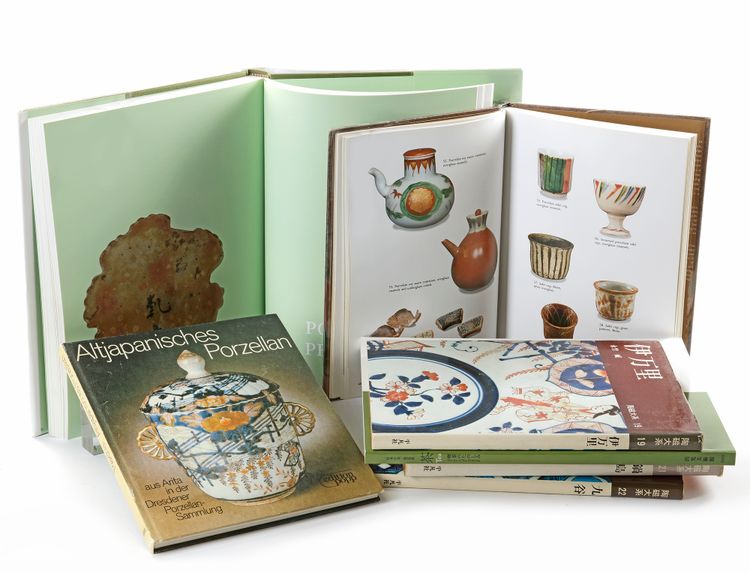EIGHT BOOKS ON JAPANESE CERAMICS
"Reichel, Friedrich. Altjapanisches Porzellan - Arita Porzellan in der Dresdener Sammlung. Leipzig: Edition Leipzig, 1980. 156 Pages, German text. Richly illustrated in full colour images. A summarised overview of the Japanese porcelain in the collection of the Zwinger museum in Dresden, Germany. A short historic introduction into the European trade in Japanese porcelain in the 16th and 17th Century. A very good introduction into the history and various types of decorated Japanese porcelain. Cardozo, Sidney B. & Hirano, Masaaki. The Art of Rosanjin. Tokyo: Kodansha, 1987. First edition. 164 Pages, illustrated in colour and black and white. Kitaji Rosanjin (1883 / 1959) was the pseudonym for a noted artist and epicure during the early to mid-Showa period of Japan. His real name was Kitaji Fusajir, but he is best known by his artistic name, Rosanjin. A man of many talents, Rosanjin was also a calligrapher, ceramicist, engraver, painter, lacquer artist and restaurateur. Idemitsu Museum of Art. The Joy of Tea Drinking. Tokyo: Idemitsu Museum of Art, 2010. First edition. 142 Pages, illustrated in colour. Main text in Japanese, Foreword and list of plates in English. This exhibition catalogue features tea ceremony utensils for matcha and sencha as well as related paintings and other masterpieces of crafts from the Idemitsu collection, amounting to about 120 items. Wilson, Richard L. The Potter's Brush: The Kenzan Style in Japanese Ceramics. New York: Merrell Publishers Ltd, 2001. First edition. 239 Pages, richly illustrated in colour. Ogata Kenzan (1663-1743) is celebrated as Japan's first and foremost individual potter. His reputation is both a product of his own time and of the modern age: the esteem in which he was held in Japan was ignited in the West as critics, art dealers, and collectors vied for his colourfully painted and inscribed work at the beginning of the twentieth century. Charles Lang Freer (1854-1919) was the world's principal collector of Kenzan wares, acquiring artefacts ranging from original pieces by Kenzan to late nineteenth-century forgeries. This range is presented here for the first time. The story of Freer's collection uncovers the secret history of the complex relationships between makers and connoisseurs, and between individual creativity and artisanal work, relationships that often operate across centuries. Abundantly illustrated in full colour, with a complete inventory of the Freer Collection, this radical survey offers new ways of looking at both the works themselves and the strategies whereby their status has been established in the art world. Koyama, Fujio et al. Toji Taikei Volume 19: Imari. Tokyo: Heibonsha, 1973. First edition. 138 Pages. Illustrated mainly in black and white, some colour photographs. Text in Japanese. Koyama, Fujio et al. Toji Taikei Volume 20: Kakiemon. Tokyo: Heibonsha, 1977. First edition. 138 Pages. Illustrated mainly in black and white, some colour photographs. Text in Japanese. Koyama, Fujio et al. Toji Taikei Volume 21: Nabeshima. Tokyo: Heibonsha, 1973. First edition. 128 Pages. Illustrated mainly in black and white, some colour photographs. Text in Japanese. Nishida, Hiroko. Toji Taikei Volume 22: Kutani Ware. Tokyo: Heibonsha, 1978. First edition. 142 Pages. Illustrated mainly in black and white, some colour photographs. Text in Japanese."


